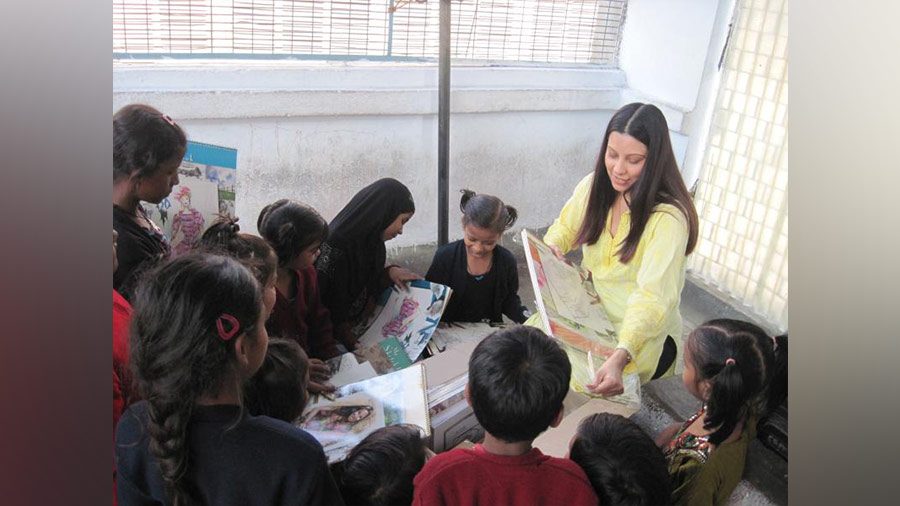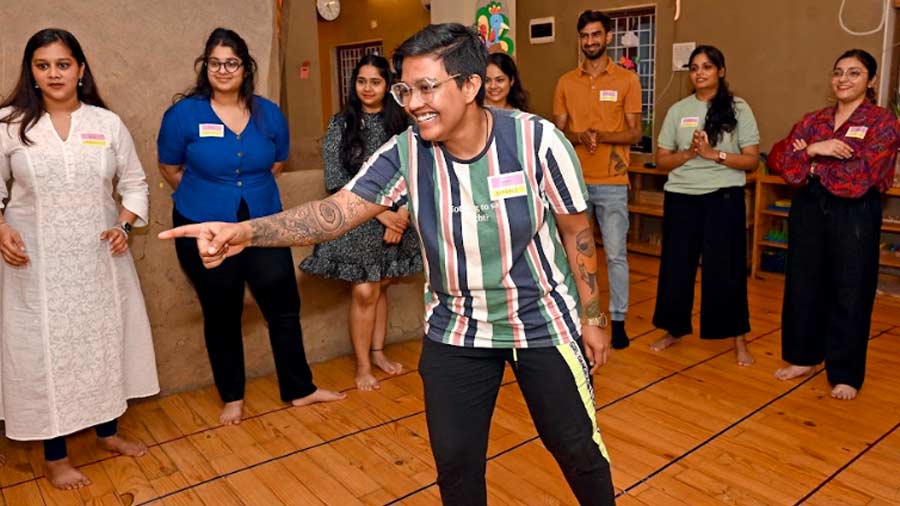Maya (name changed) was abused by her father as a child and used to scream her head off every time a young man came near her. She found her peace and solace behind the camera – in photography. Today, she is a well-adjusted young girl who is going from strength to strength.
Parul (name changed) didn’t speak a word. People around her assumed she was hearing and speech impaired. She participated in art classes, but refused to communicate. One day she suddenly started answering questions about the painting she had done, leaving everyone stunned.
These are just two of hundreds of children who are finding their way back to themselves after experiencing immense trauma through the work of Paint Our World.
Started by Priya Virmani, Paint Our World (POW) is a non-profit organisation that works to emotionally empower underserved children who have been through traumas like sexual abuse and being orphaned through tested, child-sensitised art-based activities. The idea that began in a small, dilapidated school in Sonagachhi, now caters to over 570 children across six centres in Delhi and one in Kolkata.
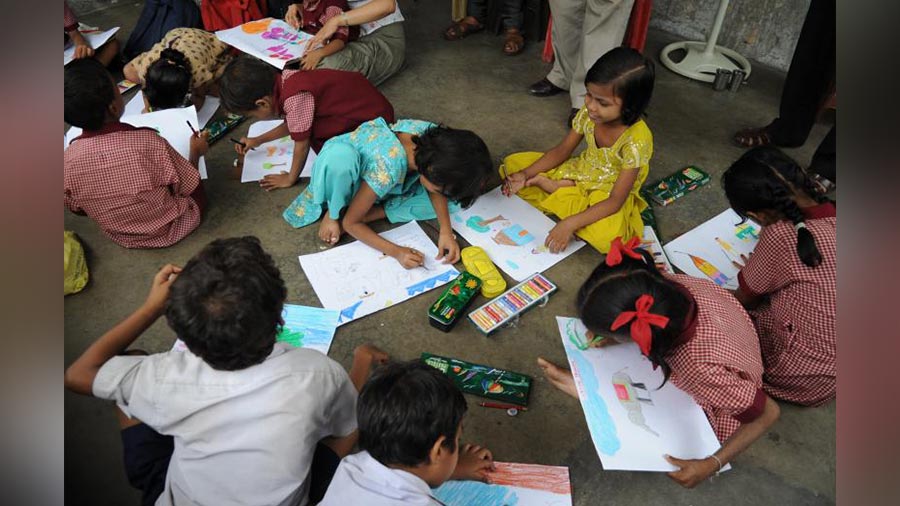
The children of POW busy drawing
“The children Paint Our Children works with are neglected by the media narrative because they are not trafficked. Trafficking entails two things, change in geographical location and exchange of money. Neither of this happens to these kids, but they come from rough areas where they are raped, abused and abandoned, and not enough light shone on the plight of these children,” said Virmani, who is on a one-woman crusade to give the chance of a better life to the underserved children who have suffered severe trauma, abuse, violence and deprivation.
How the seed was planted
According to Virmani, who is a political and economic analyst, a writer, a TED Talk speaker and a passionate advocate for women's issues based out of the UK, it was Loreto nun Sister Cyril who was the catalyst for her deep dive into working with children. But the seed of it was sown on a rainy morning in Kolkata, when she was four-years old. “I came across two children who were rummaging through rubbish on the way to my school, Loreto House. The older child took out something from one of the bin bags and gave it to the little one to eat. Till date, that image remains vivid in my mind. That night I had a very simple question for my parents — why can’t these children sit on a table and chair and eat, like me? So, I really feel that the seed was planted with that question,” said Virmani.
That seed was nurtured through working at a Mother Teresa’s children’s home every Thursday and working with Sister Cyril’s Rainbow Children throughout her school life. It was further developed by visits on special days to the slums with her father and handing out things like stationery and books to children. While studying economics at University of Bristol, Virmani worked a lot with charities as a volunteer including the Panda Project, which worked with primary school children from dysfunctional homes and homes with addiction and violence.
“We would create all sorts of activities for them, and many of them had severe behavioural issues. That’s when I started reading about how we can try and balance the mind. If something is weighing you down, how do you move from the emotional centre to the prefrontal cortex, the logical centre. I was intrigued by it and read up on it in the library when I was taking breaks from my essay writing and PhD deadlines,” said Virmani.
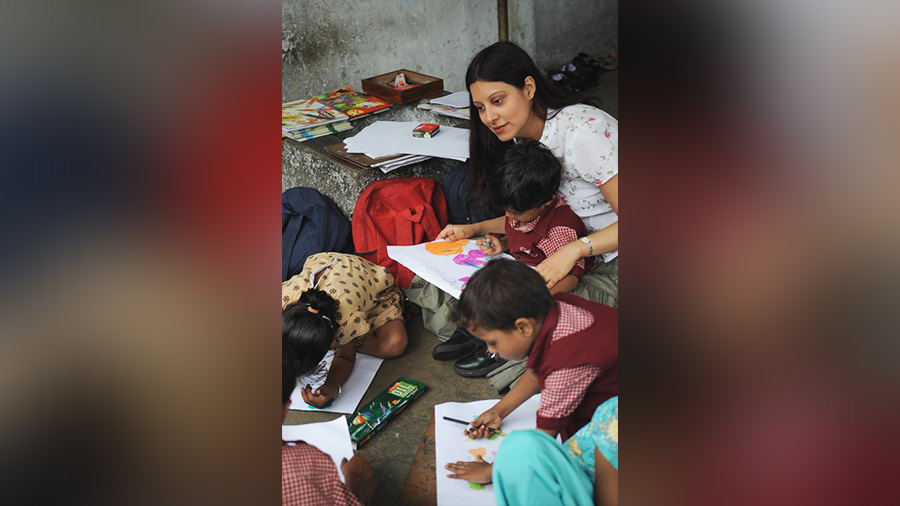
Priya with the little artists
It was on her visits to Kolkata, after her father passed away, that she got introduced to a group of children in Sonagachhi.
“Sonagachhi was, to me, the most egregious place I had been to and it made me very uncomfortable, energy-wise. I am a flexible person, but I remember feeling like I just wanted to get out. I was taken to the terrace of this dilapidated building and introduced to a bunch of children, and I really forgot where I was. For two or three hours, we sang and danced and it was so much fun,” said Virmani.
Focussing on art therapy
She ended up organising a Christmas party for the children at Millennium Park where she had drawing kits as return gifts and many of the children immediately sat down and started to paint what they were seeing. “That’s when I thought, I had read about art therapy, why don’t I use art in a therapeutic way so that they can express their world. So, I sought permission and started going everyday while I was in India and started doing art classes with them. I realised how transformative it is for the children. But it increasingly became difficult to work in that area and that’s when Sister Cyril told me that I had to work with her children,” said Virmani.
Even though the Rainbow Children project was close to her heart, Virmani wasn’t ready to commit to it as she was heading back to London. While talking to Sister Cyril, a group of children walked by, among whom was a five-year-old girl that Virmani really took a liking to.
Rejigging her life
“Once they left, Sister Cyril told me that the little girl had been regularly raped by her father and when the mother tried to stand up to him, she was knifed. When I heard the story, something in me shifted. I decided to get a team together and also get psychologists on board. To fund it, I transferred my earnings from the UK. That was how Paint Our World was set up in 2013,” said Virmani.
Virmani rejigged her life to be able to spend more time in India with her boots on the ground. She travelled to cities and villages across India to understand the issues being faced by the children. “I also did not want to raise the question of ‘she lives abroad, what does she know’,” said Virmani, who sat down with top child psychologists in Fortis Hospital in Delhi to design the original curriculum.
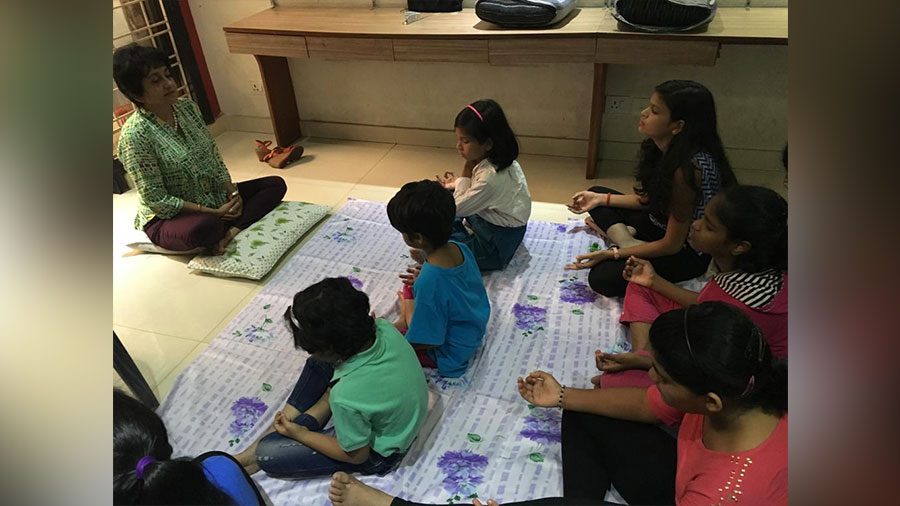
Activity-based therapy in one of the POW centres
Paint Our World started working with shelter homes in Delhi and Kolkata, where their basic needs like food, shelter, clothing were being taken care of, but their school retention rates were appalling. “You are getting the child admitted to school with such difficulty, but how do you get the child to stay when the child has such huge, unresolved issues. There is no understanding of self, or interpersonal skills, so how can a child integrate into a social milieu like a class or a school? This is where Paint Our World comes in. I think it is crucial to raise an able child. With Paint Our World, within months, the school retention rates jumped,” said Virmani.
Building greater awareness
Paint Our World employs people with different skill sets for each centre to cater to different forms of therapy — sports, theatre therapy, talks, dance and movement, and art — and their pedagogy is a dynamic, dialectical process, so it is adapted and refitted according to the needs of the children. “With every year, our psychological know-how of how to handle trauma in children is also building and growing. There is greater awareness and better understanding of what tools to use and how,” said Virmani.

A painting done by a girl in POW Kolkata. She believes the lion will protect her and eat away people who tease or beat her
Virmani feels that Paint Our World has developed a curriculum that is powerful and can empower any child, anywhere, who has been through a trauma. As a well-being counsellor, she counselled parents and children from conventional homes during the pandemic who also have been through very dark experiences.
“There are powerful ways in which such experiences can be processed and can be healed. Because of the plasticity of childrens’ brains, in three months, I can see the kind of effect that in an adult I may never see or might take 10 years to happen. If the kids are left to grow with that trauma, then it is very hard as adults. It spills into who you are, the quality of your relationships and the kind of parents they will become,” said Virmani, who hopes to tie up with more shelter homes to reach out to more children.

A six-year-old painted a house, tree, animal and road caught in a storm. But the sky, she said, is outside the storm, with a shining sun and white clouds
But her biggest desire is to get corporate India to back programmes like Paint Our World. “Because I had really little funds, just my own savings, I had to come up with something cost effective for Paint Our World. Our spending is little compared to other charities. In fact, our spending is disproportionate to our impact,” said Virmani. “That’s why I want to tell the story of Paint Our World. Because corporate India could easily back something like this where just for a few hundred rupees a month per child, they can ensure a transformative impact on their lives,” she added.
‘The real victory’
Some of the children Paint Our World started the journey with are now preparing for IAS exams and engineering entrance tests. But success for Paint Our World is defined differently.
“It is the little ways in which the children show that they are becoming more confident, more self-assured and growing into their potential selves. That’s the real victory,” said Virmani, whose book The Smallest Stories to Extraordinary, a collection of true stories that turn trying times into a celebration of life, will be launched on Monday as part of an event in the UK Parliament to celebrate the contributions and achievements of inspiring Indian women in the UK.
